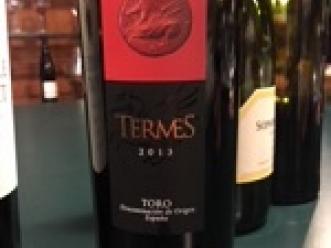Last week, LVMH, owner of Moët Hennessy, Louis Vuitton and many other famous luxury labels, announced that it has purchased Bodega Numanthia Termes. The Toro winery will be in good company – Moët Hennessy also owns Dom Pérignon, Veuve Cliquot and many other well-known wine brands.
Numanthia Termes commands high prices for its top wines, and with good reason.
Two Numanthia-Termes wines earned excellent scores from Wine Spectator: Toro Termanthia 2004 received a score of 96 and Toro Numanthia 2004 earned a 95 in this year’s “Ultimate Buying Guide.”
Just a few years ago, Toro wines were known for their reasonable prices, but quality Toro wines were hard to find. Not so any longer. The Toro DO is on the map, and it’s here to stay.
One of several Spanish wine regions located along the Duero River, the Toro DO encompasses the town of the same name as well as 14 other towns and villages. Most Toro vineyards lie south of the river. Toro’s weather can be quite extreme, as is typical for areas with continental climates. Rainfall is scarce, often less than 13 inches per year. Temperatures vary from about 12 degrees Fahrenheit to over 98 degrees.
The Toro DO celebrates its 20th anniversary this year. Founded in 1987 with just four wineries, Toro was known from the beginning for its red wines. These reds are nearly always made from tinta de Toro grapes, an indigenous tempranillo clone. In fact, 78% of Toro’s vineyards are planted with tinta de Toro. Other popular grape varieties include garnacha, malvasía and verdejo. Toro’s soil has been unusually resistant to phylloxera. This has allowed many old vines to continue to grow. It’s not unusual to find wines made from grapes grown on 40-, 50-, and sometimes even 100- and 150-year-old vines.
Toro today boasts 44 wineries (and counting), and the DO is becoming increasingly well-known. Toro’s premier wines, particularly those produced by Bodega Numanthia Termes, Bodegas y Viñedos Pintia and Bodegas y Viñedos Maurodos, can easily hold their own against the world’s top wines. Robert Parker predicted in 2004 that Toro would be one of Spain’s top wine regions by 2015.
If you plan to visit Toro, you’ll find that the region is still quite rural. Many villages in the DO have just a few hundred residents. There are two paradors, or government-operated hotels, in the area: the four-star Parador de Tordesillas and the Parador de Zamora, located in an elegant 15th-century palace, also a four-star property. You can find several other independent and chain hotels in Zamora, which is about 24 miles from Toro. Once you settle into your room, it’s time to head out and taste some wine.
Bodegas Fariña is one of Toro’s best-known wineries. Wine writer John Radford called its owner, Manuel Fariña, “the man who put Toro on the map” in The New Spain: A Complete Guide to Contemporary Spanish Wine. Bodegas Fariña’s Colegiata and Gran Colegiata wines helped bring Toro into the international spotlight.
The bodega has two wine stores, one in Toro and one in Zamora. If you wish to visit the winery, you must arrange your visit in advance.
The renowned Grupo Vega-Sicilia has established a strong presence in Toro with Bodegas y Viñedos Pintia (website in Spanish only). Pintia 2004 Red received Juan Peñin’s top score for Toro in his Peñin Guide to Spanish Wine 2007.
And then there’s the Eguren family. Known primarily for their Rioja wineries, the Egurens began the Dominio de Eguren winery in Toro with just one vineyard, and have expanded to become a major presence in the DO. The Egurens created the recently-sold Numanthia Termes winery, using old vines, carefully regulating production and applying their knowledge and talent to every step of the winemaking process.
The Egurens also produce good-value non-DO wines. Their Protocolo Blanco, Rosado and Tinto wines (white, rosé and red, respectively) and Codice Tinto (red), which are classified as Vinos de la Tierra de Castilla, deliver good quality at bargain prices. Stephen Tanzer (of International Wine Cellar) called Protocolo Tinto 2004 “a remarkable bargain.”
Toro is definitely a DO on the move. As more winemakers invest in Toro vineyards, quality will continue to improve. It’s only a matter of time, I believe – and I’m not alone – before Robert Parker’s prediction becomes a reality.


